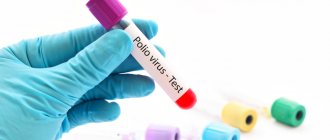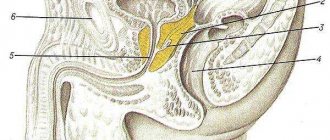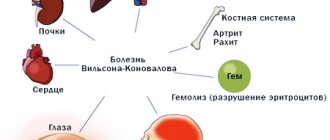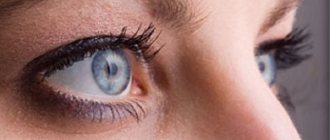Causes of inflammation of the sciatic nerve
Elimination of pain is not the main criterion in the treatment of sciatica (the medical term for damage to the sciatic nerve). If the cause of nerve compression is left unattended, pathological abnormalities will worsen, and painful discomfort will become a constant companion. Over time, chronic pain will affect your psycho-emotional state and performance.
The sciatic nerve branches off from the central organ of the nervous system at the lumbar level, runs along the inner wall and posterior surface of the pelvis, and covers the ischial tubercle. Continuing its path, it innervates the muscles of the thighs, which are responsible for the flexion-extension function of the knee joints. Dividing in the area of the popliteal fossa into the tibial and tibial, through the lower leg it reaches the feet and toes.
Provocateurs of inflammation of the sciatic nerve are damage, pinching, and infectious lesions of its fibers in the innervation zone. Most often, sciatica (pain radiating along the nerve) manifests itself as a clinical symptom:
- degeneration and dystrophy of cartilaginous intervertebral layers - osteochondrosis, hernia, protrusion;
- injuries to the musculoskeletal system - bruises, dislocations, fractures;
- infectious diseases - herpes, measles, rubella, tuberculosis, HIV;
- formation of neoplasms – malignant and benign tumors, exostoses:
- piriformis syndrome.
The role of catalysts is played by: endocrine and metabolic disorders, hormonal changes, toxic poisoning, hypothermia, increased physical activity, sedentary work.
An incorrectly administered injection into the buttock area provokes inflammation of the sciatic nerve.
Injections for pregnant women
During pregnancy, the likelihood of a pinched nerve increases due to changes in the position of the pelvic bones and increased pressure on the spine. Therefore, you need to understand what is used in such situations.
For pregnant women, injectables are used as soon as possible. Most drugs taken orally enter the circulatory system. This may cause harm to the fetus. Their use is unacceptable during pregnancy. Therefore, pregnant women receive injections when pain occurs.
It must be taken into account that some injectables are acceptable. Steroids are not given to pregnant women in most cases
It is not recommended to choose medications without the participation of a doctor. During pregnancy, local remedies are more often used: ointments, massages, gymnastics, traditional medicine.
Symptoms of sciatica
There are cases where sciatica led not only to temporary loss of ability to work, but also to disability of the patient. Therefore, you need to be especially wary of the manifestation of symptoms such as:
- pain in the buttock and lumbar spine (neuralgia);
- fatigue and aches of the lower extremities;
- impaired sensitivity of the skin in the affected area - numbness, tingling, burning, sensation of “crawling goosebumps”;
- “chilliness” of the feet, excessive sweating, or lack of sweating;
- coarsening and thickening of the stratum corneum on the sole;
- change in the structure, shape, color of the nail plates.
The main harbinger of problems is pain that is detected by episodic attacks of varying intensity. “Piercing shoots” are localized in the gluteal muscle area, along the back of the thigh and lower leg, and can spread to the foot and fingertips. Mostly the sciatic nerve hurts on one side of the body, but involvement of both limbs in the pathological process cannot be ruled out. Lying on your back, the pain subsides, but when you try to lift your leg, it returns with renewed vigor.
With severe lesions, patients experience:
- partial or complete atrophy of muscle tissue;
- dryness, thinning, peeling, change in skin color;
- decrease, disappearance of tendon reflexes;
- difficulty in bending a limb (sometimes paralysis).
Signs of pinching or inflammation of the sciatic nerve appear both individually and in complex combinations. The direct impact on the pathology clinic is the compression of nerve fibers and the degree of damage.
What is pinching?
The sciatic nerves are large and long. They are located on the sides of the lower back, extend to the toes, and innervate not only the vertebral structures, but also the pelvic organs. Therefore, pinching of the nerve roots leads to disruption of their functioning. This speeds up the diagnosis of pathology and allows you to quickly begin treatment.
Pinching of the sciatic nerve can be triggered by the formation of inflammatory edema and persistent muscle spasm. But most often, compression occurs when an acute bone growth (osteophyte) or lumbar intervertebral disc is displaced.
Standard drug treatment for sciatica
To get rid of inflammation of the sciatic nerve, you need to relieve the pain reaction, improve blood supply, and stimulate metabolic and regenerative processes in the affected area. Various methods are used for this purpose. Patients should understand that treatment of pinching is a lengthy process that requires an integrated approach. Age-related changes become a stumbling block, therefore, the older the person, the more strength and patience will be required.
For severe pain, the following is used as standard therapy:
- drugs from the NSAID group (Diclofenac, Indomethacin, Ibuprofen) - for the first 3 to 5 days the drugs are administered intramuscularly, then taken in the form of tablets or rectal suppositories;
- complex of B vitamins (Neuromultivit) – 2 – 3 tablets per day for a monthly course.
Ointments with a warming effect, containing capsicum extract, bee or snake venom, camphor, turpentine, and menthol, help to locally anesthetize the inflamed nerve.
Muscle relaxants, angioprotectors and microcirculation correctors have proven themselves well in the treatment of sciatica, but the drugs can only be used as prescribed by a doctor.
Quick help
Now about what to do when the sciatic nerve hurts, but medications do not help or the patient needs a speedy recovery. No matter how much rumor may convince you otherwise, complete treatment of sciatica in 2 days is impossible. But blocking trigger points along the sciatic nerve significantly alleviates the condition. During the procedure, painkillers (novocaine, lidocaine) or glucocorticosteroids (prednisolone, diprospan) are injected into soft tissue structures located close to the nerve roots. The passage of the pain impulse is blocked in one session by introducing medicinal substances into the space above the spinal membrane. The measures help to quickly cure sciatica, or rather eliminate its clinical manifestations.
How to treat a pinched sciatic nerve with folk remedies
Inflammation of the sciatic nerve is a case when treatment with folk remedies is not refuted, but is welcomed. Fighting the disease in different directions allows you to achieve positive results and consolidate them. Let’s analyze how to treat sciatica at home, and what alternative medicine offers for inflammation. 1If your leg really hurts, a balm made from the shoots of wild rosemary will quickly relieve the discomfort. Raw materials are sold by pharmacies and are freely available. 50 ml of olive or linseed oil is mixed with 2 tbsp. plants. Heat well in a water bath. Leave in a warm place for 10 – 12 hours, filter. Massage movements are rubbed along the sciatic nerve. 2A rub that contains capsicum will help relieve the pain of a pinched nerve. To prepare it, first crush and mix: 1 tbsp. celandine, aloe leaf (the plant must be at least 3 years old), 1 pod of red hot pepper. The ingredients are placed in a dark vessel and poured with a glass of vodka or medical alcohol. Insist for a week in a place protected from light. The finished composition is carefully rubbed into problem areas. 3A dough application will help cure inflammation. For this purpose, rye flour is kneaded with water to an elastic consistency. The mass is placed on the painful area, covered with cling film and a warm cloth, and left for 2 - 2.5 hours.
Water treatments
With all due respect to the centuries-old experience of successful healings, one cannot blindly believe in folk methods. We are talking about the supposedly miraculous properties of baths, steam rooms, saunas visited during an exacerbation. A hot bath during pinching can increase soft tissue swelling and inflammation, thereby increasing compression of nerve fibers. In addition, the activities are completely contraindicated for hypertensive patients and people prone to blood clots.
You can enjoy the relaxing effect of water procedures after going through the active phase of the disease. For sciatica during a period of stable remission, the use of medicinal baths is practiced subject to the following conditions:
- temperature regime not higher than 39º;
- water should not cover the heart area;
- The duration of the procedure is no more than 15 minutes;
- After the session, mandatory rest for 1.5 - 2 hours.
Plant materials help to relax spasmodic muscles, improve microcirculation and metabolism in the problem area. In this case, folk remedies for a pinched sciatic nerve will come in handy.
Young pine shoots (1.5 kg) are poured with boiled water (4.5 l), simmered over low heat for 10 - 15 minutes. Close the lid tightly and leave for 3 – 4 hours. Add the decoction to the water without filtering.
Add chopped calamus roots (300 g) into boiling water (4 liters). Keep on low heat for 30 minutes. The recipe can be modified by mixing calamus in equal proportions with creeping thyme.
10 – 15 treatment procedures will relieve the residual effects of the inflammatory process. For preventive purposes, the course is repeated after 3 to 6 months.
Physiotherapy
You can and should resist the insidiousness of sciatica with the help of specially selected exercises. Rehabilitators claim that a simple gymnastic complex, when used daily, is an effective treatment for the sciatic nerve. In addition, strengthened back and buttock muscles are reliable protection against chronic exacerbations.
Classes are carried out in a supine position.
- Bend your legs at the knees, hold them with your hands, and pull them to your chest. The pelvis and shoulders are lifted off the mat, trying to lie on the lower back without straining it. After a minute they return to their starting position.
- Straighten your arms to the sides from the body. Bring your knees together and bend your legs. Without lifting your shoulder blades from the mat, turn your pelvis and lower your legs at an angle of 40º-45º (not lower) to the floor surface. Having fixed the pose for 2 - 3 seconds, the movement is repeated in the opposite direction.
- Place your hands under your lower back and lift your straightened legs up as far as possible. Alternately, the legs are bent and extended at the knee joints. The exercise is similar to riding a bicycle.
All movements are performed without strain - slowly, carefully, avoiding severe pain.
Treatment of inflammation of the sciatic nerve with folk remedies and gymnastic exercises is appropriate if the symptoms are mild and the pain does not limit the patient’s movements.
Prevention
If you have never encountered sciatica before, then you need to make every effort to prevent this from happening in the future. And for this you will have to remember the folk wisdom: “Movement is life, and life is health.” Only physical education will help to avoid this unpleasant phenomenon, like a “shot” in the leg or a pinched sciatic nerve.
Moreover, you need not only to move more, especially if a person leads a sedentary lifestyle, but also to perform exercises aimed at strengthening muscles and developing the elasticity of ligaments.
At risk are office workers, salespeople, dentists, hairdressers and other people whose work involves prolonged sitting or long periods of standing still. During the working day, you need to do a small warm-up at least once every hour and a half, perform simple exercises to get your blood flowing and stretch your muscles.
The best exercise is considered to be the “swallow”. It uses many muscles, helps to form a strong muscle corset, and evens out posture. Low-amplitude squats and leg stretching exercises are no less effective.
If you have to spend a lot of time at the computer, then create the most comfortable and safe environment for your health. Use comfortable orthopedic chairs, and if you can’t buy them, then at least place a hard cushion under your lower back.
Avoid uncomfortable positions and unnatural bends in the lumbar region.
Massage manipulations
Comprehensive treatment for sciatica must include massage.
The procedure easily eliminates compression of nerve fibers by spasmed muscle tissue and displaced joint elements. Mechanical action stimulates capillary currents, normalizes local homeostasis, and saturates body cells with oxygen. The easiest and most affordable way to stretch the sciatic nerve area at home is a cupping vacuum massage. For the procedure, you will need a vacuum jar (volume 7 cm) with a rubber pump or device for pumping out air and a pump. Sequence of actions:
- cover the painful area with a thick cream or oil;
- place the jar, having previously pumped out the air, on the upper part of the lower back;
- using zigzag or circular movements, slowly move the vessel to the sacrum, buttock, back of the thigh, lower leg, up to the heel.
During the massage, be sure to ensure that no air gets into the jar.
If a nerve is pinched close to the spinal cord, any massage manipulation should be performed by a qualified specialist. It is understood that this is not just a medical worker, but a professional who has the appropriate accreditation, confirmed by a diploma and certificate. The same requirements apply to the treatment of infringement with acupressure (point impact on active points of the body) and manual techniques.
Before massaging the sciatic nerve at home, you should make sure there are no hidden indications.
Diagnostics
What should you do if you suspect you have sciatica?
First, you need to contact your primary care physician and get a referral for an MRI. Magnetic resonance imaging will help establish the correct diagnosis and show what caused the compression of the sciatic nerve - a hernia, oncology or another problem.
A visit to a specialized doctor - neurosurgeon, neurologist, traumatologist, chiropractor without an MRI simply does not make sense. None of them can make a diagnosis by touch.
In addition to MRI, you may need an X-ray of the spine, performed in two projections, as well as an ultrasound, which helps to see the condition of the nerve along its entire length. Ultrasound examination can determine the degree of compression of the nerve in the soft tissues.
To find out exactly in which area the conduction function was impaired, electroneuromyography is prescribed. But all these additional studies will be prescribed by a specialized doctor during the diagnostic process.
So, for a correct diagnosis, the doctor prescribes:
- MRI;
- X-ray of the spine in two projections;
- Ultrasound of the sciatic nerve;
- electroneuromyography.
Diet
To quickly cure sciatica, you need to get rid of extra pounds and properly balance your diet. You will have to “say goodbye” to fried, salted, smoked, spicy dishes. Overcome cravings for baked goods, carbonated drinks, fast food and alcohol. There is no need to transform into a strict vegetarian, but there is a taboo on fatty meats, lard, and rich broths.
The basis of nutrition for sciatica should be food rich in fiber, vitamins and minerals. It is better to focus on raw vegetables, fruits and freshly squeezed juices. 2-3 times a week you can treat yourself to fish dishes, 1-2 times - beef liver, boiled chicken or turkey breast. Only a third of the total daily diet is allocated to animal food. Priority applies to cereals, cereals, wholemeal bread, bran, milk and its products with a low fat content.
Ideally, treatment of the sciatic nerve at home should be carried out in close cooperation with qualified specialists, after collecting complete diagnostic information. The root cause of the failure may be severe pathological disorders that will require active drug correction or surgical intervention. You cannot rely on rubbing and compresses when it comes to your own health.










